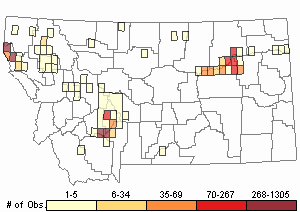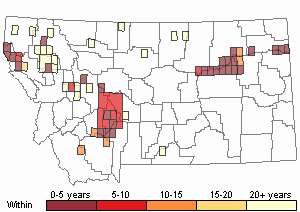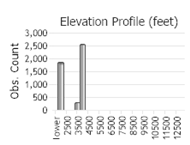View in other NatureServe Network Field Guides
NatureServe
Montana
Utah
Wyoming
Idaho
Wisconsin
British Columbia
South Carolina
Yukon
California
New York
Eurasian Water-milfoil - Myriophyllum spicatum
Other Names:
Eurasian Watermilfoil, [including hybrid Eurasian Water-milfoil]
State Rank Reason (see State Rank above)
Myriophyllum spicatum was first documented in Lake County in 1973 and has been a listed noxious weed in Montana since 2003. Hybrids formed by crosses between the native and exotic Myriophyllum spicatum are also noxious in Montana. It was intentionally introduced in North America for use in water gardens, and is now present through most of North America (Parkinson et al. 2011). A conservation status rank is not applicable (SNA) because exotic plants are not a suitable target for conservation activities.
General Description
PLANTS: Aquatic perennials with rhizomes and finely dissected, whorled leaves. Stems are branched and tawny colored when dry. Wintering buds (turions) are absent. Sources: DiTomaso and Healy 2003; Parkinson et al. 2011.
LEAVES: Submerged leaves are well-develop, in whorls of 4 to 5, and to 25 mm long. Each submerged leaf is pinnately divided into 24 to 50 linear segments. Emerged leaves are actually bracts; they are small, grow during flowering (or when water levels recede), occur below the flowers, and are oppositely arranged. Sources: DiTomaso and Healy 2003; Lesica et al. 2012.
INFLORESCENCE: Terminal spike of 4-8 cm long that grows erect above the water (emerged). The spike consists of separate male and female flowers growing in the axils of oppositely arranged leaf-like bracts. Sources: DiTomaso and Healy 2003; DiTomaso and Healy 2003.
Phenology
Flowering in Montana has been observed from July through September.
Diagnostic Characteristics
Montana has 1 exotic and 3 native Water-milfoil species. Their identification requires a close examination and users should consult either the
Manual of Montana Vascular Plants (Lesica et al. 2012) or
Flora of the Pacific Northwest-2nd Edition (Giblin et al. [eds] 2018).
Eurasian Water-milfoil -
Myriophyllum spicatum, exotic, noxious, invasive:
* Combination of flowering spikes with emergent leaves less than 4 mm and whorled submerged leaves with 14 to 24 pairs of segments that ascend.
* Submerged leaves have linear segments that are mostly equal in length.
* Vegetative shoot tips are often dense.
* Plants readily collapse when removed from water.
* Turions (cylinders or balls of small leaves) are absent.
Common Water-milfoil -
Myriophyllum sibiricum, native, desirable:
* Combination of flowering spikes with emergent leaves less than 4 mm and whorled submerged leaves with 4 to 16 pairs of segments that mostly spread or are perpendicular to the apex.
* Submerged leaves are often in whorls of 4 with 6-16(-24) segments. Segments spread or lay perpendicular to the rachis at base, but may ascend towards the apex.
* Plants remain stiff when removed from water.
* Lower pair of segments are longest and gradually shorten towards the leaf tip.
* Turions present: dark green, broadly cylindrical, composed of reduced and thickened leaves, and may remain persistent on next year’s new growth.
Hybrid Eurasian X Common Water-milfoil, exotic, noxious, invasive:
Historically, the relationship of
Myriophyllum spicatum and
Myriophyllum sibiricum has been unclear, but recent treatments indicate they are unique species. Where both species are present, the populations can intergrade producing hybrids with intermediate characteristics (DiTomaso and Healy 2003). Genetic testing is necessary when morphological characteristics are in doubt (Thum personal communication). In Montana the hybrid has been found in waterbodies where both species occur and will grow invasively. Hybrids have not been found in water bodies that lack one of these species, indicating they are self-reproducing (Thum personal communication). Herbicides that traditionally control Eurasian Water-milfoil are not effective on hybrid plants (Thum personal communication).
Whorled Water-milfoil -
Myriophyllum verticillatum, native, desirable:
* Emergent leaves are longer than the flowers and fruits and pinnately divided or lobed more than half-way to mid-vein.
* Flowers have 8 stamens.
* Submerged leaves are generally in whorls of 4, often with 12-22 segments.
* Fruit segments are round(-ish) with shallow, longitudinal ridges and no wings or cross-ribs.
* Turions present (balls of small leaves that develop from tips of vigorous vegetative shoots): brown to red-brown and 1-5 cm long.
Common Hornwort -
Ceratophyllum demersum, native, desirable:
* Submerged leaves have linear-forked segments that whorl around the stem. They are not pinnately divided (no central mid-rib).
* Flowers are submerged, but usually plants are sterile and reproduction is mostly by overwintering turions (Lesica et al. 2012).
Species Range
Montana Range
Range Descriptions

 Non-native
Non-native
Range Comments
Introduced throughout North America; native to Eurasia (Lesica et al. 2012).
For maps and other distributional information on non-native species see:
Nonindigenous Aquatic Species Database from the U.S. Geological Survey
Invasive Species Habitat Tool (INHABIT) from the U.S. Geological Survey
Invasive Species Compendium from the Centre for Agriculture and Bioscience International (CABI)
EDDMapS Species Information EDDMapS Species Information
Observations in Montana Natural Heritage Program Database
Number of Observations: 4827
(Click on the following maps and charts to see full sized version)
Map Help and Descriptions
Relative Density

Recency



 (Observations spanning multiple months or years are excluded from time charts)
(Observations spanning multiple months or years are excluded from time charts)
Habitat
Open water of reservoirs; valleys (Lesica 2012). It tolerates moving water and wave action facilitates fragmentation (Parkinson et al. 2011).
Ecology
Dispersal occurs primarily by stem fragments and root crown buds (Parkinson et al. 2011). Plants are easily broken by wave action and recreational equipment (Parkinson et al. 2011). In addition, axillary buds easily break off to form new plants. The native water-milfoil species lack buds that easily detach (DiTomaso and Healy 2003; Parkinson et al. 2011).
Eurasian Water-milfoil is an indicator of eutropic (low dissolved oxygen levels coupled with high organic matter) conditions (Parkinson et al. 2011). It grows well in hard, alkaline waters. It also grows well in salinity levels up to 10 parts per thousand (ppt) and survives at 20 ppt salinity (Parkinson et al. 2011).
Plant fragments can root in a wide range of substrates and depths (Parkinson et al. 2011). It roots best in late summer in shallow water (1.6 feet deep) and in rich organic sediment. It roots poorly in coarse sand and gravel substrates. Established plants grow well from 1-4 meters (2-13 feet), and in deeper waters if light penetration is sufficient. Growth is hindered by low light penetration and high dissolved particulate matter.
As an exotic plant, Eurasian Water-milfoil lacks controls that can limit its population. Its prolific growth can outcompete native aquatic vegetation, limiting the plant diversity that provides food for an array of animal life. Dense populations can improve the survival of young fish, but reduces foraging space for predator fish, changing the natural dynamics (Parkinson et al. 2011). The sloughing of lower leaves accumulates on the floor and adds significant amounts of phosphorus and nitrogen to the water column, which increases the internal nutrient loading to a lake (Parkinson et al. 2011). Dense populations decrease dissolved oxygen, which may also change water temperatures (Parkinson et al. 2011).
Reproductive Characteristics
FLOWERING SPIKE
On the same plant male and female flowers are separate on the flowering spike. The spike has male flowers in the upper portion and female flowers in the lower portion, with bisexual flowers sometimes occurring in between (DiTomaso and Healy 2003; Parkinson et al. 2011). Flowers are in whorls of four within the axils of leaf-like bracts [emergent leaves] (DiTomaso and Healy 2003; Parkinson et al. 2011). The leaf-like bracts are opposite and 1-3 mm long (DiTomaso and Healy 2003; Lesica 2012). Female flowers have a vestigial calyx and corolla, and a 4-lobed pistil; bracts are entire to pectinate (dissected) (Lesica 2012). Male flowers have small, deciduous, pink petals and 8 stamens; bracts are narrowly ovate and entire (Lesica 2012).
As the fruits mature, the stem below a spike doubles in thickness and bends to position the spike horizontal to the water surface (DiTomaso and Healy 2003). The nodes on a spike often have dark hydathodes, which are small, gland-like structures that passively secrete water (DiTomaso and Healy 2003).
FRUIT
Fruits are 4-ribbed (or grooved) mericarps of about 2-3 mm long (DiTomaso and Healy 2003; Lesica 2012). Each mericarp breaks apart into four 1-seeded nutlets (DiTomaso and Healy 2003; Lesica 2012).
LIFE CYCLE [Adapted from Parkinson et al. 2011]
Eurasian Water-milfoil overwinters under ice and begins growing in the early spring. Growing stems branch near the water’s surface and slough off lower leaves. In Montana flowering has been observed from July to September. As the spikes emerge, female flowers ripen before male flowers. The mode of pollination is unclear; wind and/or insects might be important (DiTomaso and Healy 2003). Fruiting spikes are horizontal to the water’s surface. Maturing fruits detach and float for a length of time before sinking (DiTomaso and Healy 2003). Fruits have a stony inner surface that must rupture or decompose inhibiting seed germination and prolonging seed dormancy for up to 7 years (DiTomaso and Healy 2003). Although flowering is prolific, seed germination is erratic and seedlings are considered rare. Most reproduction occurs by plant fragmentation. Axillary buds also easily detach to start new plants.
Management
Eurasian Water-milfoil spreads primarily through plant fragments on boat trailers, recreational equipment, and waterfowl. It can also disperse between water bodies by wind and water flow. Following introduction, populations expand rapidly and may be undergo cycles of dominance and dieback.
DETECTION [Adapted from Newton et al. 2016]
A traditional polymerase chain reaction (PCR) assay was developed to detect pure and hybridized Eurasian Water-milfoil. In 2013 a pilot study tested its use in the laboratory and at four sites in Jefferson Slough, Jefferson County, Montana and Half Moon Lake, Michigan. Results showed that the environmental DNA (eDNA) PCR assay was able to detect both pure and hybridized Eurasian Water-milfoil. The research recommended that further studies to refine the sensitivity of the assay be conducted. The technique of using eDNA for early detection of Eurasian Water-milfoil is possible.
PREVENTION [Adapted from Parkinson et al. 2011]
* Thoroughly rinse any mud and debris from all equipment and wading gear, and drain the water from the boat before leaving access areas. Pump the bilge before entering another water body as Eurasian Water-milfoil can remain alive in bilge water for several days. Use boat-washing stations when available.
* Remove all plant fragments from the boat, propeller, and boat trailer. Fragments as little as 1-inch long with two nodes are able to root and colonize.
* Dry boats and equipment for 5 days before transporting them to a new water body.
* Do not dispose aquarium water or plants into water bodies.
* Desiccate plant material and/or dispose by securely sealing in plastic bags and placing in the trash for disposal.
* Learn to identify Eurasian Water-milfoil and report findings to the Montana Department of Agriculture; Montana Fish, Wildlife and Parks; County Extension agent; or Weed Coordinator.
CHEMICAL CONTROL [Adapted from Parkinson et al. 2011]
Diquat, Endothall, 2,4-D, Triclopy, and Fluridone have been used to herbicide Eurasian Water-milfoil plants in water bodies. Native water-milfoil are also susceptible to some of these herbicides. The herbicide concentration, exposure time before dissipating, timing of chemical control, and other factors are critical to effectively hinder Eurasian Water-milfoil and reduce impacts to native vegetation – see Parkinson et al. 2011, and always follow chemical label instructions and use restrictions. These herbicides must be applied by applicators with an Aquatic Pest Control license. Consult your County Extension Agent and/or Weed District for more information on herbicidal control.
MECHANICAL CONTROL [Adapted from Parkinson et al. 2011]
Raking and hand-harvesting can be effective for controlling small populations or early infestations. However, the risk of spread by fragmenting the plants is very high. Fragment barriers around harvest operations have been developed. All plant material should be bagged and desiccated before placing in the trash for disposal. Single harvests should be done when biomass is at its peak. It is recommended to harvest several times during the growing season, and for consecutive years. Areas harvested once can re-generate.
PHYSICAL CONTROL [Adapted from Parkinson et al. 2011]
Benthic barriers are mats laid down on the floor of the water body around docks and other high-use areas. They prevent light from penetrating and prevent plants from rooting. They are usually effective, but kill all vegetation. They are removable once the infestation has been destroyed. Barriers must be monitored because sediment will accumulate and provide a substrate for Eurasian Water-milfoil to colonize. Plants can root in 4 cm (1.5 inches) of soil.
Drawdowns lower the water levels to expose plants. This method has been effective at killing plants and reducing infestations when timed with freezing temperatures for 96 hours. This control may require extensive planning and permitting, and may hurt non-targeted vegetation and animal life.
BIOLOGICAL CONTROL [Adapted from Parkinson et al. 2011]
Two insects are being studied for their ability to control Eurasian Water-milfoil: Watermilfoil Moth (Acentria ephemerella) [native to Europe] and milfoil weevil (Euhrychiopsis lecontie) [native to North America].
CULTURAL CONTROL [Adapted from Parkinson et al. 2011]
Non-native water-garden plants should never be dumped near to or within wetlands, streams, rivers, lakes, or ponds. Before purchasing plants, verify that the plant is not invasive.
Contact information for Aquatic Invasive Species personnel:Montana Fish, Wildlife, and Parks Aquatic Invasive Species staffMontana Department of Natural Resources and Conservation's Aquatic Invasive Species Grant ProgramMontana Invasive Species Council (MISC)Upper Columbia Conservation Commission (UC3)Stewardship Responsibility
Threats or Limiting Factors
Eurasian Water-milfoil grows aggressively producing dense populations that damage healthy aquatic ecosystems (Duncan 2013).
* Dense canopies at the water surface which can obstruct navigation, exacerbate flooding, and clog irrigation and hydropower structures.
* Dense populations reduce the diversity of native aquatic vegetation and animal species. It alters the predator-prey relationships of fish.
* Its fast growth dissolves oxygen underneath its canopy, shifts pH levels, captures sediment, and slows down water flow.
References
- Literature Cited AboveLegend:
 View Online Publication
View Online Publication DiTomaso, J.M. and E.A. Healy. 2003. Aquatic and riparian weeds of the West. Regents of University of California, Division of Agriculture and Natural Resources, Publication 3421.
DiTomaso, J.M. and E.A. Healy. 2003. Aquatic and riparian weeds of the West. Regents of University of California, Division of Agriculture and Natural Resources, Publication 3421. Duncan, Celestine. 2013. Invasive Eurasian Watermilfoil: A Threat to Montana's Waters. Kelseya newsletter, Montana Native Plant Society, Missoula, Montana.
Duncan, Celestine. 2013. Invasive Eurasian Watermilfoil: A Threat to Montana's Waters. Kelseya newsletter, Montana Native Plant Society, Missoula, Montana. Hitchcock, C.L. and A. Cronquist. 2018. Flora of the Pacific Northwest: An Illustrated Manual. Second Edition. Giblin, D.E., B.S. Legler, P.F. Zika, and R.G. Olmstead (eds). Seattle, WA: University of Washington Press in Association with Burke Museum of Natural History and Culture. 882 p.
Hitchcock, C.L. and A. Cronquist. 2018. Flora of the Pacific Northwest: An Illustrated Manual. Second Edition. Giblin, D.E., B.S. Legler, P.F. Zika, and R.G. Olmstead (eds). Seattle, WA: University of Washington Press in Association with Burke Museum of Natural History and Culture. 882 p. Lesica, P., M.T. Lavin, and P.F. Stickney. 2012. Manual of Montana Vascular Plants. Fort Worth, TX: BRIT Press. viii + 771 p.
Lesica, P., M.T. Lavin, and P.F. Stickney. 2012. Manual of Montana Vascular Plants. Fort Worth, TX: BRIT Press. viii + 771 p. Montana Department of Agriculture (MDA). 2017. Montana Noxious Weed List. February. Helena, Montana.
Montana Department of Agriculture (MDA). 2017. Montana Noxious Weed List. February. Helena, Montana. Newton, J., A. Sepulveda, K. Sylvester, and R. Thum. 2016. Potential utility of environmental DNA for early detection of Eurasian Watermilfoil (Myriophyllum spicatum). Journal of Aquatic Plant Management. 54:46-49.
Newton, J., A. Sepulveda, K. Sylvester, and R. Thum. 2016. Potential utility of environmental DNA for early detection of Eurasian Watermilfoil (Myriophyllum spicatum). Journal of Aquatic Plant Management. 54:46-49. Parkinson, H., J. Mangold, J. Jacobs, J. Madsen, and J. Halpop. 2011. Biology, ecology and management of Eurasian Watermilfoil (Myriophyllum spicatum L.). EB0193. April reprint. Montana State University Extension, Bozeman, Montana.
Parkinson, H., J. Mangold, J. Jacobs, J. Madsen, and J. Halpop. 2011. Biology, ecology and management of Eurasian Watermilfoil (Myriophyllum spicatum L.). EB0193. April reprint. Montana State University Extension, Bozeman, Montana. Thum, Ryan. 2018. Personal communication about Myriophyllum spicatum in Montana. Professor, Montana State University, Plant Sciences and Plant Pathology, Bozeman, Montana.
Thum, Ryan. 2018. Personal communication about Myriophyllum spicatum in Montana. Professor, Montana State University, Plant Sciences and Plant Pathology, Bozeman, Montana.
- Additional ReferencesLegend:
 View Online Publication
View Online Publication
Do you know of a citation we're missing? Culver, D.R. 1994. Floristic analysis of the Centennial Region, Montana. M.Sc. Thesis. Montana State University, Bozeman. 199 pp.
Culver, D.R. 1994. Floristic analysis of the Centennial Region, Montana. M.Sc. Thesis. Montana State University, Bozeman. 199 pp. Lesica, P., M.T. Lavin, and P.F. Stickney. 2022. Manual of Montana Vascular Plants, Second Edition. Fort Worth, TX: BRIT Press. viii + 779 p.
Lesica, P., M.T. Lavin, and P.F. Stickney. 2022. Manual of Montana Vascular Plants, Second Edition. Fort Worth, TX: BRIT Press. viii + 779 p.
- Web Search Engines for Articles on "Eurasian Water-milfoil"





